There’s no shortage of sunscreens out there with a long ingredients list featuring numerous problematic chemicals. Thankfully, many companies have wised up and ditched the reef-damaging, carcinogenic, skin-damaging chemicals for better ingredients.
Table of Contents
- Block Island Organics Natural Mineral Sunscreen, SPF 30
- Babo Botanicals Clear Zinc Sunscreen, Fragrance Free, SPF 30
- Kiss My Face Kids Mineral SPF 30 Natural Organic Sunscreen
- Hello Bello SPF 50 Sunscreen Mineral Lotion
- Manda Organic SPF 50 Sun Paste
- Alba Botanica Sensitive Mineral Sunscreen, Fragrance Free, SPF 30
- Goddess Garden Organics Everyday Natural Sunscreen Lotion, SPF 30
- How to choose a safe sunscreen
The best sunscreens for human health are those that use a mineral block to protect the skin from ultraviolet rays. Sunscreens formulated with zinc oxide tend to offer better protection against UVA rays compared to titanium oxide and organic chemicals and zinc oxide is also stable in sunlight. These non-nano mineral-based sunscreens are also reef-safe (depending on other ingredients), meaning that they don’t damage coral reefs like other chemical sunscreens containing oxybenzone and octizonate, along with other ingredients.
Here are my top picks for the best natural sunscreen brands, with more info on new innovations in sunscreen and reef-safe sunscreens below the recommendations.
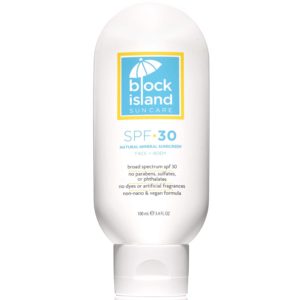
Block Island Organics Natural Mineral Sunscreen, SPF 30
Highlights: EWG award-winning reef-safe sunscreen made in the USA using organic ingredients and non-nano zinc oxide. Lightweight application, non-greasy, and fast-drying, suitable for babies, kids, and adults. Vegan-friendly, cruelty-free, and eco-friendly, with no parabens, sulfates, phthalates, dyes, or artificial fragrances.
Block Island Organics at a glance:
- SPF: 30
- UV Coverage: Full
- Reef-Safe? Yes
Ingredients: Active Ingredients: Zinc Oxide 22%. Inactive Ingredients: Aloe Barbadensis Leaf (Aloe Vera Gel) Juice, Aqua (Deionized Water), Butyrospermum Parkii (Shea) Butter, Camellia Sinensis (Green Tea) Leaf Extract, Cocos Nucifera (Coconut) Oil, Eucalyptus Globulus (Eucalyptus) Oil, Gluconolactone, Glycerin, Lecithin, Octyl Palmitate, Simmondsia Chinensis (Jojoba) Seed Oil, Sodium Benzoate, Sodium Laurylglucosides Hydroxypropylsulfonate, Tocopherol (Vitamin E), Xanthan Gum, Zemea Propanediol. (Certified Organic).
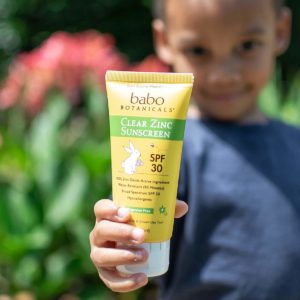
Babo Botanicals Clear Zinc Sunscreen, Fragrance Free, SPF 30
Highlights: An ocean-safe sunscreen based on zinc and recently reformulated for easier application. Free from sulfates, parabens, phthalates, dyes, and fragrances, and made with certified organic ingredients.
Babo Botanicals at a glance:
- SPF: 30
- UV Coverage: Full
- Reef-Safe? Yes
Ingredients: Active Ingredient: Zinc Oxide 16.0%. Inactive Ingredients: Arachidyl Alcohol, Arachidyl Glucoside, Behenyl Alcohol, Bisabolol*, Butyloctyl Salicylate, Butyrospermum Parkii (Shea Butter), Calendula Officinalis Flower Extract*, Caprylhydroxamic Acid, Caprylyl Glycol, Carthamus Tinctorius (Safflower) Seed Oil, Cellulose Gum, Cetearyl Alcohol, Cetyl Alcohol, Chamomilla Recutita (Matricaria) Flower Extract*, Citric Acid, Coco-Glucoside, Cocos Nucifera (Coconut) Oil, Glycerin, Helianthus Annuus (Sunflower) Seed Oil, Methyl Dihydroabietate, Microcrystal- Line Cellulose, Nasturtium Officinale Flower/Leaf Extract*, Polyhydroxystearic Acid, Pueraria Lobata Root Extract*, Sodium Gluconate, Sodium Hyaluronate, Sodium Stearoyl Glutamate, Spiraea Ulmaria Flower Extract*, Theobroma Cacao (Cocoa) Seed Butter*, Tocopherol, Water (Aqua). *Certified Organic Ingredients
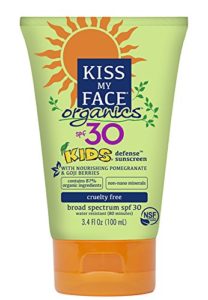
Kiss My Face Kids Mineral SPF 30 Natural Organic Sunscreen
Highlights: Natural reef-safe sunblock made in the US with 87% certified organic ingredients. Suitable for kids and adults and offers 80 mins water resistance. Awarded a #1 rating by the Environmental Working Group for Safe Sunscreens, with no synthetic fragrances, oxybenzones, parabens, phthalates, or other chemicals.
Kiss My Face at a glance:
- SPF: 30
- UV Coverage: Full
- Reef-Safe? Yes
Ingredients: Active Ingredients: Titanium Dioxide 6%, Zinc Oxide 6%. Inactive Ingredients: Cera Alba (Beeswax)*, Helianthus Annuus (Sunflower) Oil*, Lycium Barbarum (Goji Berry) Extract, Punica Granatum (Pomegranate) Extract, Sesamum Indicum (Sesame Oil)*
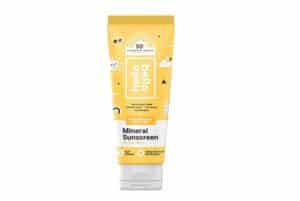
Hello Bello SPF 50 Sunscreen Mineral Lotion
Highlights: Broad-spectrum protection from this reef-safe, FDA-approved sunscreen that protects against all three types of UV rays (UVB, UVA2, and UVA1). Vegan and cruelty-free, with non-nano zinc and organic ingredients. Water-resistant to 80 minutes and suitable for kids and adults.
Hello Bello at a glance:
- SPF: 50
- UV Coverage: Full
- Reef-Safe? Yes
Ingredients: Active Ingredient, Zinc Oxide (20%) Inactive Ingredients, Arachidyl Alcohol, Arachidyl Glucoside, Behenyl Alcohol, Bisabolol*, Butyloctyl Salicylate, Butyrospermum Parkii (Shea) Butter*, Calendula Officinalis Flower Extract*, Camellia Sinensis Leaf Extract*, Caprylhydroxamic Acid, Capryloyl Glycerin/Sebacic Acid Copolymer, Caprylyl Glycol, Cellulose Gum, Cetearyl Alcohol, Cetyl Alcohol, Chamomilla Recutita (Matricaria) Flower Extract*, Citric Acid, Citrus Aurantium Dulcis (Orange) Peel Oil, Coco Glucoside, Cocos Nucifera (Coconut) Oil*, Cucumis Sativus (Cucumber) Fruit Extract*, Diheptyl Succinate, Glycerin, Methyl Dihydroabietate, Microcrystalline Cellulose, Polyhydroxystearic Acid, Persea Gratissima (Avocado) Fruit Extract*, Prunus Armeniaca (Apricot) Kernel Oil*, Sodium Gluconate, Sodium Hyaluronate, Sodium Stearoyl Glutamate, Theobroma Cacao (Cocoa) Seed Butter*, Tocopherol, Triethyl Citrate, Vanilla Planifolia Fruit Extract, Water *Certified Organic
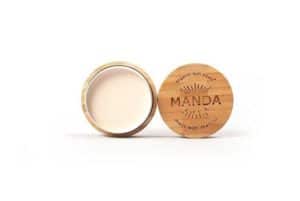
Manda Organic SPF 50 Sun Paste
Highlights: Organic, effective, reef-safe sunscreen that helps condition your skin and is kid-friendly. Comes in a gorgeous plastic-free box that will make you the envy of the beach! Non-toxic, and perfect for surfers, hikers, climbers, and lounging in the sun. (Not vegan though, despite the marketing; contains beeswax.)
Manda Organic at a glance:
- SPF: 50
- UV Coverage: Ful
- Reef–Safe? Yes
Ingredients: Active Ingredient: Non-nano zinc oxide (20%). Inactive Ingredients: Organic Coconut Oil, Organic Beeswax, Organic Cocoa Butter, Thanaka, Organic Cacao Powder, Organic Shea Butter, Organic Cinnamon Oil.
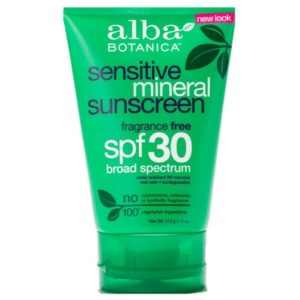
Alba Botanica Sensitive Mineral Sunscreen, Fragrance Free, SPF 30
Highlights: Broad-spectrum protection from this vegan-friendly, biodegradable, sunscreen based on titanium dioxide and zinc oxide. Unfortunately, this one isn’t totally reef-safe as it contains phenoxyethanol, so avoid using it at the beach.
Alba Botanica at a glance:
- SPF: 30
- UV Coverage: Full
- Reef-Safe? No (despite brand’s claims – contains phenoxyethanol)
Ingredients: Active Ingredients: Titanium Dioxide 2.0%, Zinc Oxide 14.5%. Inactive Ingredients: Aqua (Water), Caprylic/Capric Triglyceride, Dimethicone, Ethylhexyl Palmitate, Sorbitan Sesquioleate, Glycerin, Glyceryl Isostearate, Butyrospermum Parkii (Shea) Butter, Polyglyceryl -3 Ricineoleate, Helianthus Annuus (Sunflower) Seed Oil, Simmondsia Chinensis (Jojoba) Seed Oil, Vitis Vinifera (Grape) Seed Oil, Aloe Barbadensis Leaf Juice, Calendula Officinalis Flower Extract, Chamomilla Recutita (Matricaria) Flower Extract, Tocopheryl Acetate, Alcohol, Magnesium Sulfate, Polyhydroxystearic acid, Silica, Sodium Chloride, Benzyl Alcohol, Phenoxyethanol
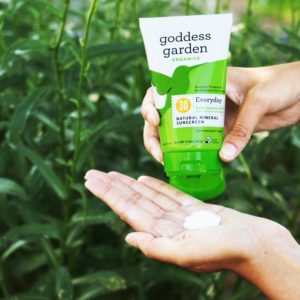
Goddess Garden Organics Everyday Natural Sunscreen Lotion, SPF 30
Highlights: Water-resistant (up to 80 mins) sunscreen made with mostly organic ingredients and zinc oxide. Vegan-friendly and Leaping Bunny certified Cruelty-Free, but not totally reef-safe as it contains phenoxyethanol. Lavender scented and free from parabens, phthalates, or synthetic fragrances. Available in a 6 oz. recyclable tube.
Goddess Garden Organics at a glance:
- SPF: 30
- UV Coverage: Full
- Reef-Safe? No (despite brand’s claims – contains phenoxyethanol)
INGREDIENTS: Active Ingredients: Zinc Oxide 20%. Inactive Ingredients: Aloe Barbadensis Leaf Juice, Arachidyl Alcohol, Arachidyl Glucoside, Behenyl Alcohol, Bisabolol, Butyloctyl Salicylate, Butyrospermum Parkii (Shea) Butter, Caprylhydroxamic Acid, Capryloyl Glycerin/Sebacic Acid Copolymer, CaprylyI Glycol, Cellulose Gum, Cetearyl Alcohol, Cetyl Alcohol, Citric Acid, Coco-Glucoside, Cocos Nucifera (Coconut) Oil, Diheptyl Succinate, Ethylhexylglycerin, Glycerin, Lavandula angustifolia (Lavender) Oil*, Methyl Dihydroabietate, Microcrystalline Cellulose, Phenoxyethanol, Polyhydroxystearic Acid, Sodium Gluconate, Sodium Hyaluronate, Sodium Stearoyl Glutamate, Theobroma cacao (Cocoa) Seed Butter, Tocopherol (Vitamin E), Water.
*Certified Organic
How to choose a safe sunscreen
The recommendations above are just a handful of many natural sunscreens where the active ingredient is zinc oxide and/or titanium dioxide. In general, what you want to avoid spray sunscreens whenever you can, especially if they contain nanoparticles, look for a short ingredient list and pick a:
- a non-chemical sunscreen with micronized zinc oxide (or titanium dioxide)
- a sunscreen with an SPF factor of 50 or lower (anything higher is misleading, according to the FDA and the Environmental Working Group)
US regulators have only approved zinc oxide and avobenzone as sunscreen ingredients that provide true broad-spectrum protection against UVA wavelengths. Avobenzone has a short-lived absorption capacity, however (it begins to break down after 30 minutes or so) (R), and there are growing concerns over the potential for avobenzone to form undesirable transformation products (including ecotoxins), particularly when it reacts with chlorine (R). As such, if your only option is a sunscreen with avobenzone, try to find one that includes other ingredients (such as triplet quenchers) that help sustain its capacity to protect the skin and avoid undesirable breakdown products (R).
There is another sunscreen option that many people are excited about – Mexoryl SX. However, the US FDA has so far failed to approve Mexoryl SX and other sunscreen chemicals for use in the US.
Mexoryl
Mexoryl SX (Ecamsule) has been widely available in Europe and in Canada for well over a decade. Sadly, though, it is currently only licensed in the US for use at a specific level in Ombrelle, a product by L’Oreal. That’s because the company stumped up the exorbitant cost to apply for an FDA license, which they received in 2006.
Mexoryl SX is a highly effective chemical sun filter and can be easily combined with other UV filters to create very high SPF formulas (R). Tests performed by L’Oreal (included in their license application) showed that Mexoryl SX absorption is very minimal (at less than 0.1%) and poses no risk to human health. Who wouldn’t want that in their sunscreen?
There is one major drawback with Mexoryl, however. Mexoryl only protects against UV wavelengths in the 290-400 nanometer range. Since this doesn’t cover the entire UV spectrum (UVB is 280 to 320 nanometers), Mexoryl must be combined with another UV filter to provide broad-spectrum coverage. Ombrelle, for example, combines Mexoryl with homosalate, octocrylene, avobenzene, and octisalate. Disappointing, right?
And things aren’t much better In Europe, sadly. There, Mexoryl SX is available as the very popular Anthelios line by La Roche Posay. This formula includes octocrylene, titanium dioxide, avobenzone, and Mexoryl, making it marginally better than the L’Oreal formula. Both Anthelios and Ombrelle contain parabens and other undesirable chemicals, though, so there’s still some work to do before we get the sunscreens we deserve.
My hope is that a product will soon be made available that includes Mexoryl alongside zinc oxide or another natural sunblock. Saffron and quercetin are two intriguing potential sunscreen ingredients that seem to confer UVB protection. In one study, a 4% saffron lotion showed an SPF value equivalent to an 8% homosalate lotion (R).
Are there any other options for natural sunscreen? Well, if you’re equally concerned about your own health and the health of the environment, you may be interested to learn of the existence of a newly patented sunscreen based on ingredients that have all been tested to ensure they don’t damage marine organisms, including coral and the ecosystem that depends on coral reefs. This sunscreen formula includes: diethylamino hydroxybenzoyl hexyl benzoate, methylene bis-benzotriazolyl tetramethylbutylphenol, ethylhexyl triazone and the preservative sorbic acid. The sunscreen has been tested and found to be just as effective as regular chemical sunscreens (R). Sadly, there is currently no consumer version of this sunscreen available, but I’ll keep checking and will add it here if/when it comes to market.
How to choose a reef-safe sunscreen
According to a report by Marine Life, a marine conservation NGO, there may be some 82,000 kinds of chemicals swilling about in the world’s oceans thanks to our use of personal care products like sunscreen. In 2015 alone, an estimated 14,000 tons of sunscreen made their way to the world’s coral reefs, where they caused irreversible damage and led to the death of many reefs.
The main culprits for coral reef damage are oxybenzone and octinoxate, two of the most widely used chemicals in sunscreens. Oxybenzone damages coral DNA (which can cause cancer and harm coral development), can disrupt the hormonal system of coral, can lead to deformities in young coral, and can lead to bleaching of coral.
These aren’t the only two chemicals causing problems for coral. Other troublesome factors in sunscreens include parabens (methyl paraben and butyl paraben, for example), and phenoxyethanol.
So, to choose a reef-safe sunscreen, avoid those that rely on oxybenzone and octinoxate, any that contain parabens, and those with phenoxyethanol on the ingredients list. It’s also best to avoid aerosol spray sunscreens as these disperse microscopic particles into the environment and typically mean a product is nano-based.
Non-nano titanium dioxide sunscreen is your best option for a reef-safe sunscreen, as long as the product is also free of the other chemicals mentioned above.
Other ways to reduce your impact include simply using less sunscreen. Stay sun-safe by using protective sunwear instead and use sunscreen with an SPF of 30 on any areas of skin that are exposed. Any higher and you’ll get minimal additional benefits but there’ll be a lot more of the chemical ingredients making their way into the environment.
Given the potential hazards associated with sunscreens, it’s worth reiterating that sunscreens should be your last resort for sun protection. You’re far better staying in the shade, wearing a sun-shirt, and carrying a parasol than covering your body with sunscreen several times a day. But, when sunscreen is necessary, your best options are to choose one of the ones recommended above!
Badger has a sunscreen that has only 4 ingredients – Zinc Oxide, Beeswax, Sunflower Seed Oil and Vitamin E. I saw on someone’s blog who has MCS (multiple chemical sensitivity) that this worked for them. I’ve also used it and I like it